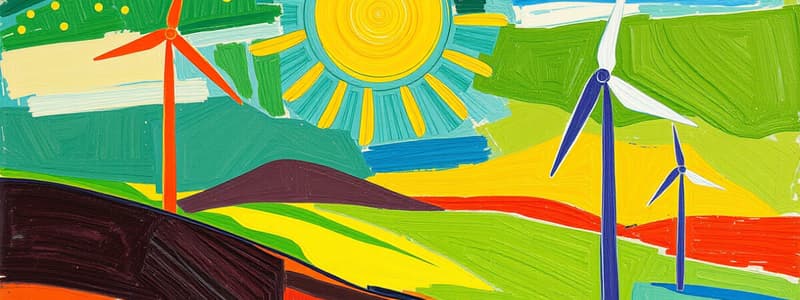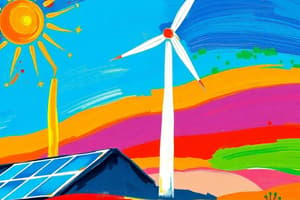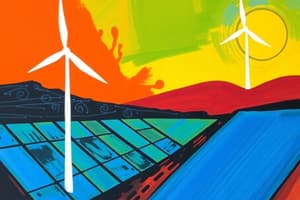Podcast
Questions and Answers
What has traditionally met the global demand for energy?
What has traditionally met the global demand for energy?
- Electricity from solar panels
- Hydropower resources
- Fossil fuels such as coal, oil, and natural gas (correct)
- Geothermal energy
What is one significant benefit of solar energy?
What is one significant benefit of solar energy?
- Minimal land use for solar farms
- Low installation costs for solar panels
- High global energy demand
- Abundant and accessible renewable energy (correct)
Which countries are leading in solar energy installations as of 2023?
Which countries are leading in solar energy installations as of 2023?
- Germany, Canada, and Brazil
- China, the United States, and India (correct)
- Australia, France, and Japan
- Italy, Russia, and Mexico
What environmental issue is significantly reduced by utilizing solar energy?
What environmental issue is significantly reduced by utilizing solar energy?
What is a challenge associated with the production of photovoltaic (PV) cells?
What is a challenge associated with the production of photovoltaic (PV) cells?
What mechanism is used to generate wind energy?
What mechanism is used to generate wind energy?
What has contributed to the growth of wind energy as a source of power?
What has contributed to the growth of wind energy as a source of power?
What is a significant drawback of large solar farms?
What is a significant drawback of large solar farms?
What is one significant socioeconomic benefit of transitioning to alternative energy?
What is one significant socioeconomic benefit of transitioning to alternative energy?
Which material development has contributed to the efficiency of wind turbines?
Which material development has contributed to the efficiency of wind turbines?
What environmental challenge is associated with the implementation of solar farms?
What environmental challenge is associated with the implementation of solar farms?
Which country is noted for being a global leader in solar and wind energy?
Which country is noted for being a global leader in solar and wind energy?
What is one of the barriers to widespread adoption of alternative energy?
What is one of the barriers to widespread adoption of alternative energy?
Which biofuel production improvement is mentioned as potentially sustainable?
Which biofuel production improvement is mentioned as potentially sustainable?
The shift to alternative energy is expected to reduce which of the following?
The shift to alternative energy is expected to reduce which of the following?
What is one ecological impact of hydropower generation?
What is one ecological impact of hydropower generation?
Which countries are currently leading in geothermal energy production?
Which countries are currently leading in geothermal energy production?
What is a primary environmental concern associated with geothermal energy?
What is a primary environmental concern associated with geothermal energy?
What is the approximate global capacity for tidal and wave energy as of 2023?
What is the approximate global capacity for tidal and wave energy as of 2023?
How does the carbon footprint of tidal and wave energy compare to that of fossil fuels?
How does the carbon footprint of tidal and wave energy compare to that of fossil fuels?
What have technological advances in alternative energy primarily achieved?
What have technological advances in alternative energy primarily achieved?
Which of the following is a key characteristic of geothermal energy?
Which of the following is a key characteristic of geothermal energy?
What is a significant drawback of extracting fossil fuels?
What is a significant drawback of extracting fossil fuels?
What distinguishes alternative energy sources from fossil fuels?
What distinguishes alternative energy sources from fossil fuels?
What are the main sources of biomass energy in Pakistan?
What are the main sources of biomass energy in Pakistan?
What is one of the challenges faced by hydropower development in northern Pakistan?
What is one of the challenges faced by hydropower development in northern Pakistan?
Which province in Pakistan is noted for using bagasse for power generation?
Which province in Pakistan is noted for using bagasse for power generation?
What is the estimated geothermal energy potential in Pakistan?
What is the estimated geothermal energy potential in Pakistan?
What significant barrier exists for biomass energy development in Pakistan?
What significant barrier exists for biomass energy development in Pakistan?
What type of energy generation is primarily still in nascent stages in Pakistan?
What type of energy generation is primarily still in nascent stages in Pakistan?
What is a major challenge for large hydropower projects in Pakistan?
What is a major challenge for large hydropower projects in Pakistan?
In which regions have preliminary studies identified geothermal potential?
In which regions have preliminary studies identified geothermal potential?
What is one significant challenge facing geothermal energy development in Pakistan?
What is one significant challenge facing geothermal energy development in Pakistan?
Which area in Pakistan is suggested to have potential for tidal energy development?
Which area in Pakistan is suggested to have potential for tidal energy development?
What percentage of Pakistan’s energy comes from renewable sources like wind and solar?
What percentage of Pakistan’s energy comes from renewable sources like wind and solar?
What is a primary reason for the need for sustainable development of alternative energy sources in Pakistan?
What is a primary reason for the need for sustainable development of alternative energy sources in Pakistan?
How much of Pakistan's total installed power generation capacity is derived from thermal sources?
How much of Pakistan's total installed power generation capacity is derived from thermal sources?
Which of the following is NOT listed as a challenge for tidal and wave energy in Pakistan?
Which of the following is NOT listed as a challenge for tidal and wave energy in Pakistan?
What is a potential benefit of fully harnessing alternative energy resources in Pakistan?
What is a potential benefit of fully harnessing alternative energy resources in Pakistan?
What part of the energy generation mix does nuclear energy represent in Pakistan's power generation?
What part of the energy generation mix does nuclear energy represent in Pakistan's power generation?
Flashcards are hidden until you start studying
Study Notes
Introduction to Alternative Energy Resources
- Global energy demand is increasing due to population growth and economic expansion.
- Traditional energy sources, mainly fossil fuels (coal, oil, natural gas), contribute to environmental issues.
- Transition to sustainable and environmentally friendly alternative energy resources is critical.
Types of Alternative Energy Resources
-
Solar Energy
- Harnessed through photovoltaic (PV) cells converting sunlight into electricity.
- Global solar energy capacity reached about 1,200 gigawatts (GW) in 2023.
- Major contributors: China, USA, and India.
- Reduces greenhouse gas emissions but involves energy-intensive production processes and potential land use concerns.
-
Wind Energy
- Generated by converting wind currents into mechanical power with turbines.
- Fastest-growing energy source globally, reliable and available 24/7.
- Estimated global geothermal energy capacity stands at 16 GW in 2023, with the USA, Indonesia, and the Philippines leading.
-
Tidal and Wave Energy
- Captures energy from ocean tides and waves, still in early development stages.
- Global capacity of around 0.5 GW as of 2023, mostly pilot projects.
- Minimal carbon footprints, but can impact marine ecosystems and navigation routes.
Comparison with Traditional Energy Sources
- Fossil fuels have caused environmental degradation, pollution, and climate change over decades.
- Alternative energies are renewable and generate little to no greenhouse gases during operation.
Technological Advances in Alternative Energy
- Solar panel efficiency improved from approximately 15% to over 22% in the past decade.
- Wind turbines designed with larger blades and better materials enhance energy capture.
- Biomass advancements, like cellulosic ethanol, show promise for sustainable bioenergy.
Socioeconomic Effects of Shifting to Alternative Energy
- New job creation in renewable sectors and economic growth potential.
- Challenges include retraining traditional energy sector workers and high initial infrastructure costs.
Environmental Impact
- Adoption of alternative energy significantly lowers greenhouse gas emissions and pollution.
- Challenges include land use for solar farms, wind turbines' effect on wildlife, and hydropower damming consequences.
Case Studies
- Germany leads in renewable energy, with over 40% of electricity from solar and wind.
- China is the largest producer of solar and wind power, illustrating feasibility of renewable transitions.
Challenges and Barriers to Implementation
- High upfront costs, inadequate infrastructure, and resistance from fossil fuel industries impede adoption.
- Hydropower potential in northern Pakistan (Khyber Pakhtunkhwa and Gilgit-Baltistan) faces challenges like long gestation periods, displacement impacts, and seasonal water flow variations.
Biomass Energy in Pakistan
- Biomass mainly sourced from agricultural waste, with potential for 5,000 MW generation.
- Challenges include policy coherence and competition with agricultural residue uses.
Geothermal Energy in Pakistan
- Exploration needed; potential estimated at 1,000 MW primarily in northern and western regions.
- High exploration costs and lack of government focus hinder development.
Tidal and Wave Energy in Pakistan
- Coastal regions offer potential, yet extensive exploration is needed.
- Initial studies indicate several hundred megawatts of tidal energy potential, but face high costs and environmental concerns.
Conclusion
- Pakistan has vast potential in alternative energy, especially in solar, wind, and hydropower.
- Systemic challenges in financing, infrastructure, and policy support must be addressed.
- Sustainable development of these resources can enhance energy security and contribute to global climate change efforts.
Studying That Suits You
Use AI to generate personalized quizzes and flashcards to suit your learning preferences.





